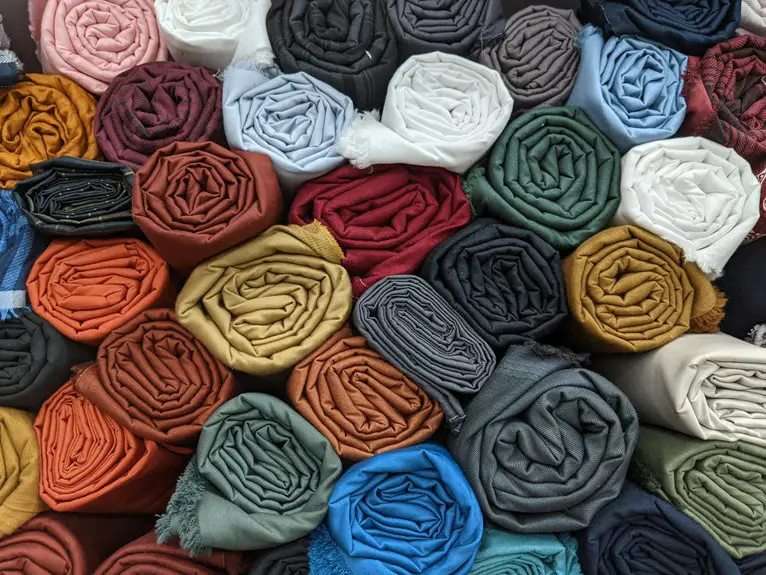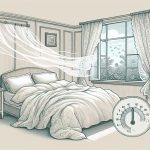When you’re choosing bed sheets, the fabric can make a big difference, especially if you have sensitive skin or allergies. Not all materials are created equal when it comes to keeping allergens at bay and ensuring a comfortable night’s sleep. Understanding which fabrics naturally resist dust mites, bacteria, and irritants can help you find sheets that suit your needs. Let’s explore some of the top hypoallergenic options that might change how you think about bedding.
Table of Contents
Key Takeaways
- Bamboo sheets naturally resist bacteria and allergens, offering softness and breathability ideal for sensitive skin.
- TENCEL™ sheets provide superior moisture-wicking and eco-friendly benefits, sourced sustainably from eucalyptus trees.
- Silk and cotton sheets offer natural breathability and hypoallergenic properties, reducing irritation and dust mite presence.
- Linen sheets are durable, moisture-wicking, and regulate temperature, suitable for various climates and allergy sufferers.
- Microfiber sheets resist dust mites effectively and are budget-friendly but may trap more heat than natural fibers.
Benefits of Choosing Hypoallergenic Bed Sheets
Although you mightn’t notice allergens in your bedding, choosing hypoallergenic bed sheets can greatly reduce irritation and improve your sleep quality.
When you switch to these specially designed fabrics, you minimize exposure to dust mites, pet dander, and mold—common triggers that cause allergic reactions. This allergy reduction lets you breathe easier and wake up feeling refreshed. You’ll find it easier to fall asleep without persistent itching or sneezing disrupting your rest.
Plus, hypoallergenic sheets often resist bacteria and moisture, creating a cleaner sleeping environment. By investing in these sheets, you actively protect your health and enhance your comfort.
Hypoallergenic sheets resist bacteria and moisture, promoting a cleaner, healthier, and more comfortable sleep environment.
Ultimately, they help you enjoy uninterrupted nights and better sleep quality, making your bed a true sanctuary from allergens.
Key Features to Look for in Hypoallergenic Fabrics
When choosing hypoallergenic fabrics for your bed sheets, focus on materials that naturally resist allergens and irritants.
Prioritize fabric breathability to keep moisture and heat at bay, which helps prevent the growth of mold and dust mites. You’ll want sheets that wick away sweat and allow air to circulate freely for a comfortable, allergen-free sleep environment.
Durability factors matter too; hypoallergenic sheets should withstand regular washing without losing their protective qualities. Look for tightly woven fabrics that maintain their structure over time, ensuring long-lasting resistance against common allergens.
Avoid synthetic blends that trap heat or irritate sensitive skin. By selecting hypoallergenic bed sheets with excellent breathability and strong durability factors, you create a healthier sleeping space that supports restful nights and reduces allergy flare-ups.
Bamboo Sheets: Natural Antimicrobial and Hypoallergenic Qualities
You’ll love how bamboo sheets naturally resist bacteria and allergens, making them perfect for sensitive skin.
They’re soft and breathable, so you stay comfortable all night without irritation.
Plus, choosing bamboo means you’re supporting an eco-friendly and sustainable option for your bedding.
Antimicrobial Benefits
Because bamboo fibers naturally resist bacteria and allergens, they make an excellent choice for bed sheets if you’re looking to reduce irritants in your sleep environment.
Their inherent antimicrobial properties help keep your sheets fresher longer without relying on harsh chemical fabric treatments. This means you get:
- Reduced growth of odor-causing bacteria
- Lower risk of dust mites and mold buildup
- A cleaner, healthier sleep surface naturally
Choosing bamboo sheets means you don’t have to worry about adding synthetic antimicrobial agents, which can sometimes irritate sensitive skin.
Instead, you benefit from a fabric that actively works to inhibit microbial growth, keeping allergens at bay. This natural defense makes bamboo an ideal option if you want hypoallergenic bedding that supports a cleaner, more comfortable night’s rest.
Skin-Friendly Properties
Although many fabrics claim to be gentle on skin, bamboo sheets truly stand out with their natural antimicrobial and hypoallergenic qualities. They reduce common allergy triggers like dust mites and bacteria, minimizing skin irritation and promoting healthier sleep. If you suffer from sensitive skin, bamboo sheets can soothe rather than aggravate, making them a smart choice.
| Feature | Benefit | Impact on Skin |
|---|---|---|
| Natural Antimicrobial | Inhibits bacteria growth | Reduces skin irritation |
| Hypoallergenic | Limits common allergy triggers | Prevents allergic reactions |
| Breathable Fabric | Enhances airflow | Keeps skin cool and dry |
| Moisture-Wicking | Draws moisture away | Prevents irritation |
| Soft Texture | Gentle on sensitive skin | Comfort and reduced redness |
Bamboo sheets offer unmatched skin-friendly comfort for allergy sufferers.
Eco-Friendly Sustainability
When choosing bed sheets, you mightn’t realize how much impact your choice has on the environment. Bamboo sheets stand out because they’re made from sustainable materials and support eco friendly practices. Bamboo grows quickly without needing pesticides or excessive water, making it a smart, green choice.
Plus, bamboo fibers naturally resist bacteria, making these sheets both antimicrobial and hypoallergenic.
By opting for bamboo sheets, you’re choosing:
- Renewable, fast-growing bamboo that replenishes itself
- Reduced chemical use during production
- Durable, biodegradable fabric that lessens landfill waste
These benefits mean you get comfy, skin-friendly bedding while helping the planet.
TENCEL™ Sheets: Eco-Friendly and Moisture-Wicking Excellence
You’ll love TENCEL™ sheets if you care about the environment and staying dry at night.
They’re made through an eco-friendly process that reduces waste and energy use.
Plus, their superior moisture-wicking keeps you comfortable by drawing sweat away from your skin.
Eco-Friendly Production Process
Because TENCEL™ sheets combine sustainability with comfort, they stand out in the world of hypoallergenic bedding.
When you choose TENCEL™, you’re supporting a production process grounded in responsible practices. The fibers come from sustainably sourced eucalyptus trees, grown on certified eco-friendly plantations. This means fewer chemicals, less water, and lower emissions compared to conventional fabrics.
Plus, TENCEL™ holds multiple eco certifications that confirm its environmental standards.
Here’s what you can expect with TENCEL™ production:
- Sustainable sourcing of raw materials guarantees minimal impact on forests
- Closed-loop manufacturing recycles solvents, reducing waste and pollution
- Strict eco certifications verify ethical and green practices
Superior Moisture Management
How does TENCEL™ keep you comfortably dry throughout the night? It excels in moisture absorption and breathability factors, ensuring you stay fresh and sweat-free. The fabric pulls moisture away from your skin, promoting rapid evaporation. This natural moisture-wicking ability prevents dampness and discomfort during sleep.
Here’s how TENCEL™ compares in moisture management:
| Feature | Benefit |
|---|---|
| Moisture Absorption | Quickly absorbs sweat |
| Breathability | Allows air to circulate |
| Drying Speed | Dries faster than cotton |
Silk and Cotton Sheets: Comfort and Skin Sensitivity Considerations
When choosing bed sheets, silk and cotton stand out for their unique benefits in comfort and skin sensitivity.
Silk benefits include its smooth texture, which feels gentle on your skin and helps reduce irritation. Cotton durability means your sheets will last through many washes without losing softness or shape.
Both fabrics offer natural breathability, making them excellent for sensitive skin.
Consider these points when picking between them:
- Silk’s hypoallergenic properties minimize dust mites and allergens.
- Cotton’s sturdiness suits everyday use and frequent washing.
- Both fabrics wick moisture away, keeping you dry and comfy.
Comparing Hypoallergenic Fabrics: Which One Suits Your Needs?
Silk and cotton each offer distinct advantages for sensitive skin, but you might find other hypoallergenic fabrics better suited to your specific needs.
Silk and cotton benefit sensitive skin, yet exploring other hypoallergenic fabrics may better meet your unique needs.
For instance, bamboo sheets are naturally resistant to allergy triggers and boast excellent breathability, making them ideal if you tend to overheat at night.
Linen is another great choice, known for its fabric durability and moisture-wicking properties, which reduce allergens by keeping your bed dry.
If you want something budget-friendly but still hypoallergenic, microfiber sheets resist dust mites effectively, though they might trap heat more than natural fibers.
When choosing, consider how fabric durability aligns with your lifestyle and how sensitive you’re to allergy triggers.
Caring for Hypoallergenic Sheets to Maintain Their Properties
To keep your hypoallergenic sheets effective and comfortable, you’ll need to follow specific care routines. Proper laundry techniques and thoughtful sheet storage play key roles in maintaining their protective qualities.
Start by washing your sheets in warm water with a gentle, hypoallergenic detergent to remove allergens without damaging fibers. Avoid fabric softeners, which can trap irritants. After washing, dry them thoroughly on a low heat setting to prevent mildew.
For sheet storage, keep them in a cool, dry place away from direct sunlight to preserve fabric integrity and prevent dust accumulation.
Remember to:
- Wash sheets regularly using allergy-friendly laundry techniques
- Dry sheets completely on a gentle cycle
- Store sheets in breathable containers or cotton bags
Following these steps helps your sheets stay fresh and allergen-free longer.
Frequently Asked Questions
Can Hypoallergenic Sheets Help Reduce Nighttime Allergies?
Yes, hypoallergenic sheets help reduce allergy triggers like dust mites and pet dander, so you’ll breathe easier and enjoy better sleep quality. They create a cleaner sleep environment, making nighttime allergies less disruptive for you.
Are Hypoallergenic Sheets Suitable for Eczema-Prone Skin?
If you have eczema-prone skin, hypoallergenic sheets can really help since they minimize eczema triggers and reduce irritation. You’ll find they’re gentle on skin sensitivity, keeping your skin calmer and less prone to flare-ups during sleep.
How Long Do Hypoallergenic Sheets Typically Last?
Hypoallergenic sheets can last like a trusty old friend, around 2-5 years. Durability factors include fabric type and quality, while fabric maintenance—like gentle washing and avoiding harsh chemicals—helps you extend their cozy lifespan considerably.
Do Hypoallergenic Sheets Require Special Detergents?
You don’t always need special detergent types for hypoallergenic sheets, but using gentle, fragrance-free detergents helps. Follow washing instructions carefully to avoid irritation and maintain fabric integrity, ensuring your sheets stay comfy and allergy-friendly longer.
Are There Hypoallergenic Sheets Safe for Babies?
Think of a gentle cloud cradling your little one. You’ll want baby friendly materials like organic cotton or bamboo sheets—they create a safe sleeping environment, free from irritants, ensuring sweet, peaceful dreams for your baby every night.
- Does Chiffon Fabric Stink - July 15, 2025
- Does Chiffon Fabric Affect the Economy - July 15, 2025
- Does Cotton Fabric Have a Nap - July 15, 2025







